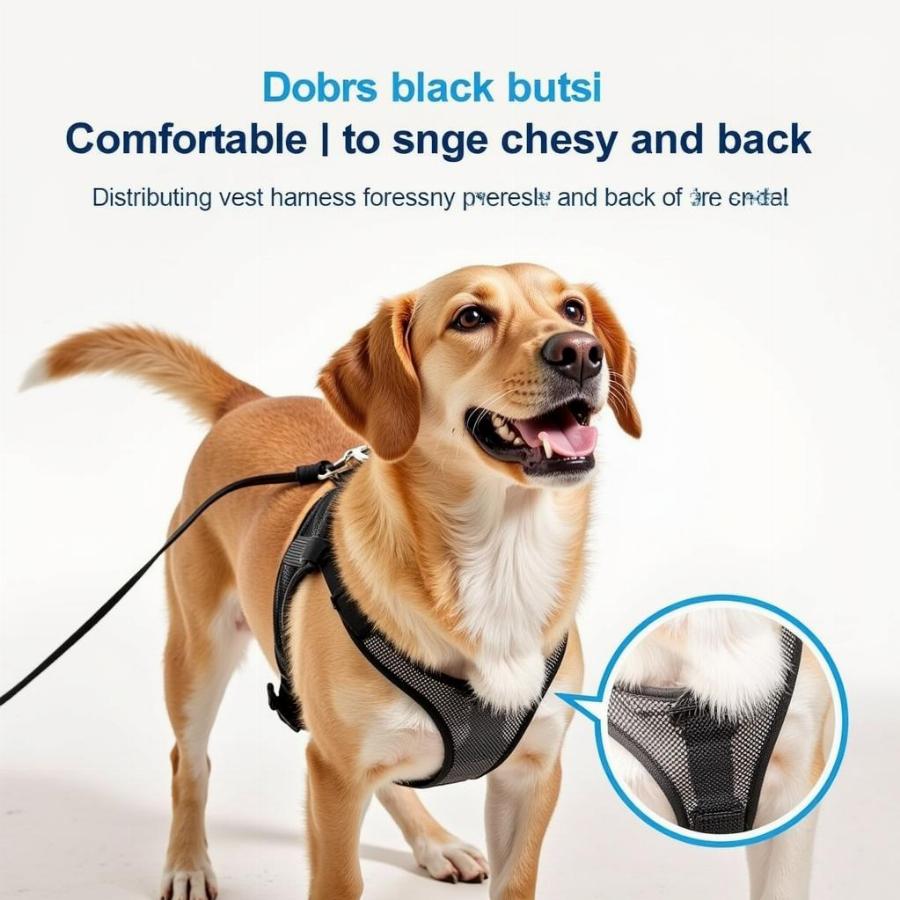Dog vest harnesses have become increasingly popular among dog owners, offering a comfortable and safe alternative to traditional collars. But with so many options available, finding the right dog vest harness can be overwhelming. This guide will help you navigate the world of dog vest harnesses, covering everything from understanding the benefits to choosing the perfect fit for your furry friend.
Why Choose a Dog Vest Harness?
A dog vest harness distributes pressure evenly across your dog’s chest and back, reducing strain on their neck and trachea. This is especially important for dogs prone to pulling, coughing, or breathing issues. Unlike collars, which can put pressure on delicate areas, a harness offers better control and prevents choking. They’re also great for puppies whose necks are still developing. Considering a dog vest harness can significantly improve your dog’s comfort and safety during walks.
What are the Benefits of Using a Dog Vest Harness?
A vest harness provides numerous advantages for both you and your dog. It offers better control, especially for strong pullers, and reduces the risk of choking or neck injuries. The even distribution of pressure makes walks more comfortable for your dog, and many harnesses feature reflective strips for increased visibility at night. Switching to a harness can be a game-changer, especially if you enjoy running with dog.
 Dog Vest Harness Benefits
Dog Vest Harness Benefits
Different Types of Dog Vest Harnesses
Various types of dog vest harnesses cater to different needs and activities. Front-clip harnesses discourage pulling, while back-clip harnesses are suitable for calm walkers. Dual-clip harnesses offer versatility, allowing you to switch between front and back clipping. Specialized harnesses exist for activities like running or working. You might consider a working dog harness for specific tasks.
How to Choose the Right Type of Harness for My Dog?
Consider your dog’s temperament, size, and activity level when selecting a harness. If your dog pulls excessively, a front-clip harness might be the best option. For relaxed walkers, a back-clip harness is sufficient. If you’re unsure, a dual-clip harness offers flexibility. Remember, choosing the right type of harness is key to a comfortable and enjoyable walking experience.
Finding the Perfect Fit for Your Dog
A properly fitted harness is crucial for your dog’s comfort and safety. It should be snug but not restrictive, allowing for a full range of motion. Measure your dog’s girth and neck circumference to determine the correct size. Always consult the manufacturer’s sizing chart for specific measurements. Just like choosing the perfect gucci dog outfit, proper fit is crucial.
How Do I Know if the Harness Fits My Dog Correctly?
You should be able to fit two fingers comfortably between the harness and your dog’s body. The harness should not chafe or restrict movement. Check regularly for any signs of wear and tear and replace the harness if necessary. Ensuring a proper fit is essential for your dog’s well-being.
Caring for Your Dog Vest Harness
Most harnesses can be washed by hand or in a washing machine on a gentle cycle. Air dry the harness completely before use. Regular cleaning prevents the buildup of dirt and bacteria, ensuring your dog’s harness stays fresh and hygienic. Consider a reflective dog collar for added safety during night walks.
Conclusion
Choosing the right dog vest harness is an investment in your dog’s comfort and safety. By understanding the different types of harnesses, finding the perfect fit, and providing proper care, you can ensure enjoyable and stress-free walks for both you and your furry companion. Remember, a well-fitted dog vest harness is a key component of responsible dog ownership.
FAQ
-
What is the best type of harness for a dog that pulls? A front-clip harness is typically recommended for dogs that pull.
-
How often should I clean my dog’s harness? Clean your dog’s harness regularly, especially if it gets dirty or wet.
-
Can I leave the harness on my dog all the time? It’s generally not recommended to leave a harness on your dog all the time.
-
What materials are dog vest harnesses made of? Dog vest harnesses are typically made of nylon, polyester, or other durable materials.
-
How do I measure my dog for a harness? Measure your dog’s girth and neck circumference to determine the correct harness size.
-
Are there harnesses for small dogs? Yes, harnesses are available for dogs of all sizes, including small breeds.
-
What if my dog chews on their harness? If your dog chews on their harness, consider a chew-resistant option or redirect their chewing behavior with appropriate toys.
Beaut Dogs is your one-stop shop for all things dog-related. We provide valuable information on all aspects of dog ownership, from breed selection to comprehensive care guides. When you need assistance, please contact us via Email: [email protected] for detailed and accurate answers from Beaut Dogs. Visit Beaut Dogs today to explore the wonderful world of dogs and learn how to care for them best!